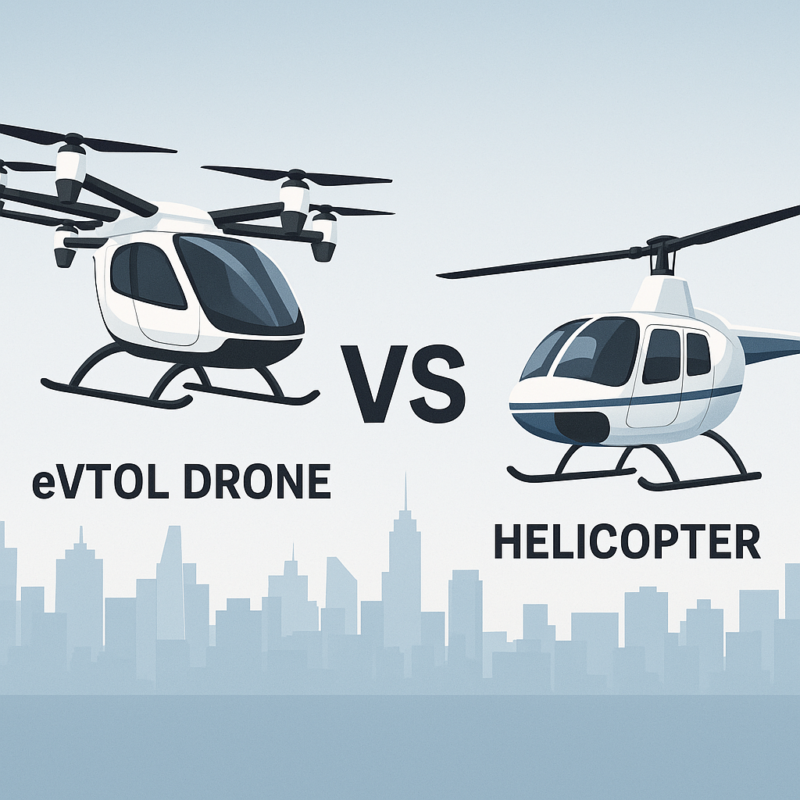Urban air mobility is no longer a futuristic dream — it’s fast becoming a practical alternative to ground transportation. As electric vertical takeoff and landing (eVTOL) drones emerge as a promising mode of commuting, it’s worth comparing them with their traditional counterparts: the 2-seater helicopter.
In this post, we dive deep into the safety, cost, and operational efficiency of commutable drones versus 2-seater helicopters, helping you understand which is more viable in the near future.
🔒 Safety Comparison: Autonomy vs Human Error
| Aspect | eVTOL Drones (Commutable Drones) | 2-Seater Helicopters |
|---|---|---|
| Redundancy | Multiple rotors, electric systems, software fail-safes | Minimal redundancy; engine/rotor failure is critical |
| Pilot Error | Autonomous or semi-autonomous, reducing human risk | Human error responsible for ~80% of crashes |
| Crash Risk | Early-stage, but promising with built-in redundancy | High relative to fixed-wing aircraft |
| Emergency Handling | Some have ballistic parachutes or controlled descent | Requires autorotation skill; hard for novices |
| Regulatory Oversight | Subject to new safety standards (FAA, EASA) | Well-established certification and inspection norms |
✅ Verdict: eVTOLs show strong potential for safer operation due to autonomy and redundancy, even though large-scale data is still in development.
💸 Cost Comparison: A New Era of Low-Cost Flight?
| Cost Factor | eVTOL Drones | 2-Seater Helicopters |
|---|---|---|
| Purchase Price | $250,000–$500,000 | $300,000–$700,000 |
| Fuel/Energy | Electric; ~$0.10–$0.25/km | Aviation fuel; ~$150–$200/hr |
| Maintenance | Low (few moving parts, mostly electric) | High (rotor maintenance, engine checks) |
| Pilot Requirement | May not need one | Licensed pilot required (~$100–$200/hr) |
| Training & Licensing | Minimal for passengers | $15,000–$30,000 for private pilot license |
| Insurance | Expected to be lower | High, due to accident history |
✅ Verdict: eVTOLs may redefine cost efficiency in air travel, especially with mass adoption and automation.
⚖️ At a Glance: eVTOL Drones vs Helicopters
| Factor | eVTOL Drone | Helicopter |
|---|---|---|
| Safety Potential | ⭐⭐⭐⭐☆ | ⭐⭐☆☆☆ |
| Operating Cost | ⭐⭐⭐⭐⭐ | ⭐⭐☆☆☆ |
| Noise Levels | ⭐⭐⭐⭐⭐ (quiet) | ⭐☆☆☆☆ (noisy) |
| Range | ⭐⭐☆☆☆ (~50–150 km) | ⭐⭐⭐⭐☆ (up to 500 km) |
| Speed | ⭐⭐⭐☆☆ (100–150 km/h) | ⭐⭐⭐⭐☆ (150–250 km/h) |
| Availability | ⭐☆☆☆☆ (pre-commercial) | ⭐⭐⭐⭐⭐ (available today) |
✈️ Final Thoughts: The Future of Personal Aerial Mobility
While helicopters are well-tested and available today, eVTOLs represent the future of affordable, low-noise, low-maintenance air commuting — especially in urban environments.
As battery tech, certification, and infrastructure mature, commutable drones may soon outpace helicopters in both safety and cost, opening the skies for short-distance travel and transforming the way we move.
Kj [/.] Sreekumar programs computers as a hobby and profession. Into programming from his school days, Sree uses Codemarvels to key in facts and fixes he finds interesting while working on different projects. Some of the articles here give away a few shades of his philosophical leanings too.


